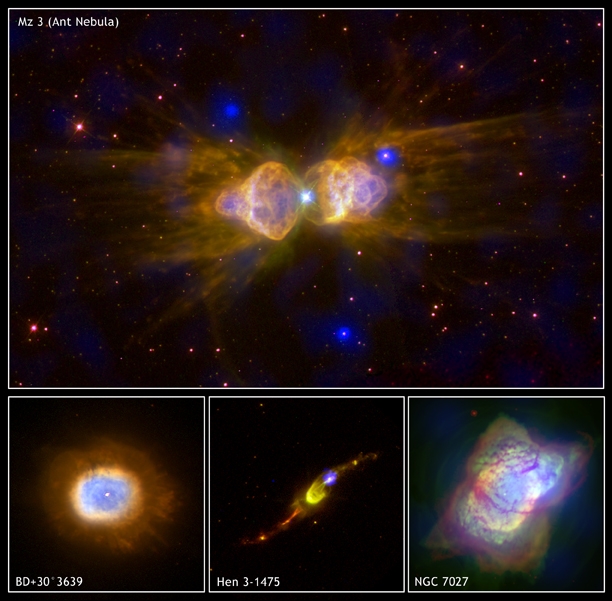
 Credit:X-ray: NASA/CXC/RIT/J.Kastner et al.; Optical/IR: BD +30 & Hen 3: NASA/STScI/Univ. MD/J.P.Harrington; NGC 7027: NASA/STScI/Caltech/J.Westphal & W.Latter; Mz 3: NASA/STScI/Univ. Washington/B.Balick
Credit:X-ray: NASA/CXC/RIT/J.Kastner et al.; Optical/IR: BD +30 & Hen 3: NASA/STScI/Univ. MD/J.P.Harrington; NGC 7027: NASA/STScI/Caltech/J.Westphal & W.Latter; Mz 3: NASA/STScI/Univ. Washington/B.Balick
Last Gasp of the Dying
Some worlds end in a whimper. When stars below a certain mass exhaust their nuclear fuel, they contract and (somehow) shed their outer layers. When this happens the stars form beautiful, incredibly detailed structures misnamed planetary nebulae. But while these stars begin their ends quietly, there's a last gasp, a final death cry, that the stars emit. This death cry takes the form of an extremely fast wind emitted from the stars surface. This wind can be revealed in X-ray images. The images above show a optical and infrared and X-ray images of four planetary nebula, along with X-ray images obtained by the Chandra X-ray Observatory. The X-ray emission is produced from the collision of the slow and fast death winds.
<
HEA Dictionary ● Archive
● Search HEAPOW
● Other Languages
● HEAPOW on Facebook
● Download all Images
● Education ● HEAD
>
Each week the HEASARC
brings you new, exciting and beautiful images from X-ray and Gamma ray
astronomy. Check back each week and be sure to check out the HEAPOW archive!
Last modified Tuesday, 27-Feb-2024 10:10:14 EST


